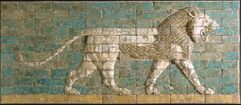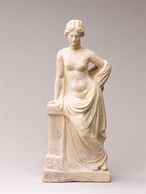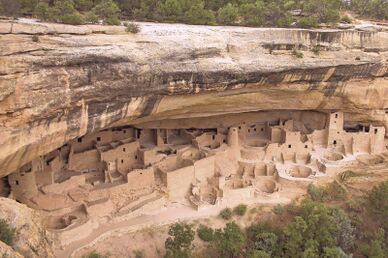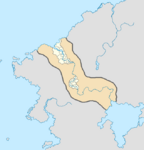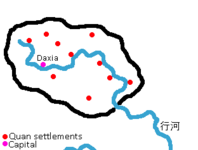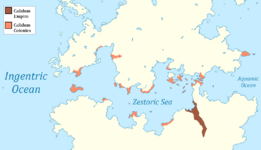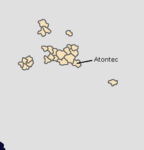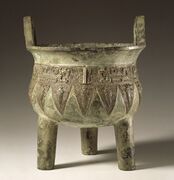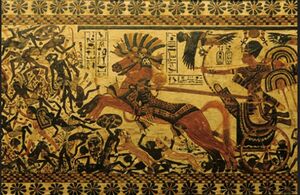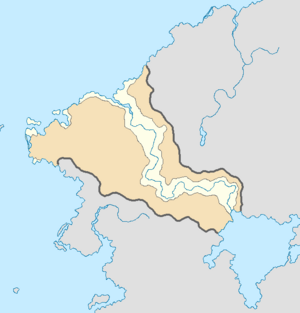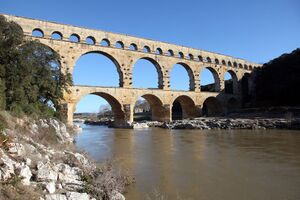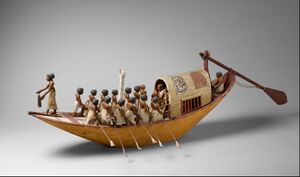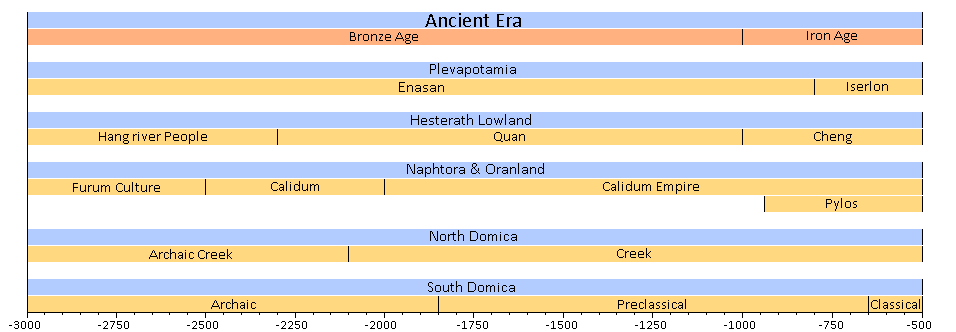Ancient Era: Difference between revisions
Philimania (talk | contribs) m (→Bronze Age) |
|||
| (18 intermediate revisions by 2 users not shown) | |||
| Line 1: | Line 1: | ||
{{Region_icon_Gentu}} | {{Region_icon_Gentu}} | ||
{{Gentu wip}} | {{Gentu wip}} | ||
{{GentuCleanup|date=1 Enero 2000}} | |||
{{multiple image|perrow = 2|total_width=400 | {{multiple image|perrow = 2|total_width=400 | ||
| image1 = 863405a52291a03ca56e1c1a3cf29910.jpg | | image1 = 863405a52291a03ca56e1c1a3cf29910.jpg | ||
| Line 7: | Line 8: | ||
| image4 = Tumblr paym133c5N1sfkq0go1 500.jpg | | image4 = Tumblr paym133c5N1sfkq0go1 500.jpg | ||
| image5 = Atontec.jpg | | image5 = Atontec.jpg | ||
| footer = Well-known Ancient artworks, each | | footer = Well-known Ancient artworks, each representing a certain civilisation. From left to right, top to bottom: depiction of 2 Calidum deities ([[Calidum Empire]]), the [[Striding Lion]] ([[Iserlon]]), the [[Qingtong Xiang]] ([[Quan]]), the [[Statue of I Ahila]] ([[Kingdom of Pylos|Pylos]]), the city of [[Atontec]] ([[Creek]])}} | ||
{{Gentish History}} | {{Gentish History}} | ||
The '''Ancient Era''', also known as '''Ancient | The '''Ancient Era''', also known as '''Ancient History''' is the period of time between the beginning of {{wp|recorded history}} and the collapse of the Iron Age. The term Ancient Era is not to be confused with the [[Antiquity Era]], the Era that followed the end of the Ancient Era. | ||
During the time period of the Ancient Era (starting roughly from 3000 BCE), the {{wp|world population}} was already exponentially increasing due to the introduction of {{wp|agriculture}}. According to estimates, the world population increased exponentially in this period. In 10,000 BCE in [[Prehistorical Era|prehistory]], the world population had stood at 2 million, rising to 45 million by 3,000 BCE. By the rise of the [[Iron Age]] in 1,000 BCE, the population had risen to 72 million. By the end of the Iron Age in Gentu in 550 BCE, the world population is thought to have stood at 109 million. | |||
== Bronze Age == | == Bronze Age == | ||
The [[ | The [[Bronze Age]] begins with the end of the [[Cuprulithic Age]]. In most areas of {{wp|civilisation}}, bronze smelting became a foundation for more advanced societies in places such as [[Hesterath]], [[North Domica]], [[Trimeshia]], and [[Oranland]]. Modern {{wp|historians}} have managed to identified 4 original civilisations which emerged in the time period. | ||
{| class="mw-collapsible toccolours" style="margin: 1em auto;" | {| class="mw-collapsible toccolours" style="margin: 1em auto;" | ||
| Line 36: | Line 37: | ||
* [[Enasan]] in [[Plevapotamia]] | * [[Enasan]] in [[Plevapotamia]] | ||
* [[Quan]] in the [[Hesterath | * [[Quan]] in the [[Hesterath lowlands]] | ||
* [[Calidum]] in northern [[Naphtora]] | * [[Calidum]] in northern [[Naphtora]] | ||
* [[Creek]] in [[Norh Domica]] | * [[Creek]] in [[Norh Domica]] | ||
The first civilisation | The first civilisation emerged in Enasan in the region of Plevapotamia in southwest [[Hesterath]], now part of modern-day XXX along the [[Exore river]]. By around 3000 BCE, XXX city-states had collectively formed civilisation with {{wp|government}}, {{wp|religion}}, {{wp|division of labour}}, and {{wp|writing}}. Among the city-states, [[Ire]] was among the most well known. | ||
The | The beginning of the [[Quan]] dynasty emerged in the Hesterath lowlands in modern day XXX <!-- country where Quan is --> along the [[Hang river]] around 2300 BCE. In this period, and there was evidence of a fully developed writing system and a centralized government based in the city of [[Daxia]]. The Quan dynasty is the first XXX regime recognized by scholars though XXX historians insist that the [[Shan]] dynasty preceded it. The Quan dynasty practiced forced labour to complete public projects. There is evidence of massive ritual burial. | ||
In northern Naphtora, the Calidum civilisation | In northern Naphtora, the Calidum civilisation emerged around 3200 BCE, developing along the [[Herito river]]. The civilisation's city-states were placed neatly on grid patterns that were located up and down the Herito river. By 2000 BCE, the civilisation was unified under one rule labeled the [[Calidum Empire]] by XXX historians. This made Calidum the first {{wp|empire}} in [[Gentu]]. They formed trade routes stretching from modern day XXX <!-- western Oranland --> to the Hesterath lowlands and their navy dominated the [[Zestoric Sea]]. | ||
In the Domicas, the earliest known civilisation of the region appeared in the western central region of modern day XXX<!-- country in Creek -->. The Creek civilisation of decentalized city-states flourished around 2100 BCE, the most well known was the city of [[Atontec]] which was abandoned for reasons unclear around 400 BCE. | |||
== Iron Age == | == Iron Age == | ||
[[File:Calidum Civil War.jpg|thumb| | [[File:Calidum Civil War.jpg|thumb|Depiction of [[Remansete II]] riding into battle in his {{wp|chariot}} during the [[Calidum Civil War]].]] | ||
[[File:Plevapotamia c. 800 BCE.png|thumb|left|upright=1|Territories of [[Iserlon]].{{legend|#FEFEE9|Territory settled by Iserlon}} {{legend|#F6E1B9|Territory claimed by Iserlon}}]] | [[File:Plevapotamia c. 800 BCE.png|thumb|left|upright=1|Territories of [[Iserlon]].{{legend|#FEFEE9|Territory settled by Iserlon}} {{legend|#F6E1B9|Territory claimed by Iserlon}}]] | ||
The [[ | The [[Iron Age]] is the second and last age of the Ancient Era, spanning from 1000 to 550 BCE. The Iron Age overall was characterized by the prevalent smelting of iron with ferrous {{wp|metallurgy}} and the use of {{wp|carbon steel}}. Smelted iron proved more durable than earlier metals such as {{wp|copper}} or bronze and allowed for more productive societies. | ||
Around 1000 BCE, the Quan dynasty was overthrown by the [[Cheng]] | Around 1000 BCE, the Quan dynasty was overthrown by the [[Cheng]] under the leadership of [[Yin Huiling]]. The Cheng dynasty was established shortly thereafter. During this era, Cheng embraced a feudal society of decentralized power. Cheng was then dissolved into a period of [[Cheng-Quan Civil War| civil war]] in 560 BCE where possibly millions of soldiers fought each other over feudal struggles. | ||
Also around 1000 BCE, native [[Flonesian people|Flonesian]] groups begun | Also around 1000 BCE, native [[Proto-Flonesian people|Proto-Flonesian]] groups begun to diverge from the original group such as the [[Auralia people|Auralian]], [[Proto-Iolana|Proto-Iolanan]], XXX and XXX. | ||
From around 950 | From around 950 to 940 BCE, Calidum plunged into [[Calidum Civil War|civil war]] between the [[Hatsepshet III|Emperor of Calidum]] and his brother [[Remansete II]]. The war ended indecisively resulting in the creation of the [[Treaty of 940 BCE|first]] recorded {{wp|peace treaty}} to be ever made. Remansete II managed gain control of the archipelego of [[Pylos]]<!-- Archipelego to the north of Calidum --> and the founding of the [[Kingdom of Pylos]] and the [[Remansete Period]]. | ||
In Plevapotamia, the Enasan city-states were united into a single states named [[Iserlon]] under the rule of [[King Adamen I]] in 783 BCE. Around the same time came the [[Endus]], the oldest known sacred texts for the [[Plecan]] religion. In 776 BCE, the first recorded [[Endoric Games]] were held with participants coming from 16 Pylosan cities. The games was hosted by [[Remansete IV]] who had a love of sports. | |||
In 550 BCE, | In 550 BCE, a {{wp|meteor}} [[Zestoric Meteor Strike|landed in the Zestoric Sea]] causing huge {{wp|tidal waves}} to hit the coasts of Pylos and Calidum. The event nearly caused the collapse of both civilisations. The event marked the end of the Iron Age and the Ancient Era, and the beginning of the [[Antiquity Era]]. | ||
== Development == | == Development == | ||
=== Religion | === Religion and philosophy === | ||
[[File:Philosophers of Calidum.png|thumb|<center>Clockwise from top left:<br>Philosphers Chisisi, Khons, Omari, and Ur.</center>]] | [[File:Philosophers of Calidum.png|thumb|<center>Clockwise from top left:<br>Philosphers Chisisi, Khons, Omari, and Ur.</center>]] | ||
The rise of {{wp|civilisation}} | The rise of {{wp|civilisation}} corresponded with the institutional sponsorship of belief in {{wp|gods}}, supernatural forces and the {{wp|afterlife}}. During the Bronze Age, many civilisations adopted their own form of {{wp|religion}}. Usually, {{wp|polytheistic}} Gods, who manifested human personalities, strengths and failings. Early religion was often based on location, with cities or entire countries selecting a {{wp|deity}}, that would grant them preferences and advantages over their competitors. {{wp|Worship}} involved the construction of representation of deities, and the granting of sacrifices. Sacrifices could be material goods, food, or in extreme cases human sacrifice to please a deity such as in [[Hoth]] in [[Religion of Creeks|Creek]] religion. Over time, a great variety of religions developed around the world, with some of the earliest major ones being [[Plecan|Plecanism]] (around 800 BCE). The [[Afran]] religions trace their origin to XXX<!-- City name -->, around 1700 BCE. | ||
The ancient Plevapotamian {{wp|philosophy}} is | The ancient Plevapotamian {{wp|philosophy}} is a fusion of two ancient traditions: [[Sauran tradition]] and [[Isorlon tradition]]. Plevapotamian philosophy begins with the ''Endus'' where questions related to laws of {{wp|nature}}, the origin of the {{wp|universe}} and the place of man in it are asked. XXX and XXX <!-- Religion name -->are continuation of the Sauran school of thought. | ||
In [[Cheng]], schools of thought were | In [[Cheng]], schools of thought were to dominate their thinking until the modern day. These were [[Weilism]], and [[Kaoism]]. The Kaoism tradition, which would attain dominance, looked for political morality not to the force of law but to the power and example of {{wp|tradition}}. Kaoism would later spread into the [[Eyoseoul peninsula]] and toward [[Horapon]]. | ||
In Calidum | In Calidum and Pylos, philosophical tradition, represented by [[Chisisi]], [[Khons]], [[Omari]] and [[Ur]], which would later influenced the thinkings of [[Oranland]] and much of northern [[Naphtora]] in the 4th to 3rd century BCE largely thanks to Calidum, and later Pylosan Imperialism. | ||
=== Science | === Science and technology === | ||
[[File:Aqueduct in Pylos.jpg|thumb|left|Aqueducts of Calidum architecture in modern day Pylos.]] | [[File:Aqueduct in Pylos.jpg|thumb|left|Aqueducts of Calidum architecture in modern day Pylos.]] | ||
In the | In the history of technology and ancient {{wp|science}} during the growth of the ancient civilisations, ancient technological advances were produced in {{wp|engineering}}. These advances stimulated other societies to adopt new ways of living and {{wp|governance}}. Sometimes, technological development was sponsored by the state. | ||
The characteristics of Calidum | The characteristics of Calidum and Pylosan technology are indicated by a set of artifacts and customs that lasted for thousands of years. The Calidum invented and used many basic contraptions, such as the {{wp|ramp}}, the {{wp|lever}}, and the {{wp|aqueduct}}, to aid construction processes such as large temples and palaces. The Calidum also played an important role in developing Zestoric maritime technology, including {{wp|merchant ship}}s, {{wp|warships}} and lighthouses. Inventions that are credited to the Pylosans such as the {{wp|gear}}, {{wp|screw}}, {{wp|bronze casting}} techniques, {{wp|water clock}}, {{wp|water organ}}, {{wp|torsion catapult}} and the use of steam to operate some experimental machines and toys. Many of these inventions occurred during the early 6th century BCE. | ||
The | The history of science and technology in Plevapotamia dates back to ancient times. The city-states of [[Enasan]] yields evidence of {{wp|hydrography}} and both {{wp|sewage collection}} and disposal being practiced by its inhabitants. Among the fields of science and technology pursued in Plevapotamia were {{wp|metallurgy}}, {{wp|astronomy}}, and {{wp|mathematics}}. The history of science and technology in the Cheng dynasty shows significant advances in science, technology, mathematics, and astronomy. The first recorded observations of {{wp|comets}} and {{wp|supernovae}} were made in Cheng. Traditional Cheng medicine, {{wp|acupuncture}} and {{wp|herbal medicine}} were also practiced. | ||
=== Maritime activity === | === Maritime activity === | ||
[[File:Model Calidum.jpg|thumb|Model of | [[File:Model Calidum.jpg|thumb|Model of a Calidum Boat.]] | ||
The | The history of ancient navigation began in earnest when men took to the sea in {{wp|planked}} boats and ships propelled by sails hung on masts, like the [[Narmar ship]] from 600 BCE. | ||
The Calidum and Pylosans were seafaring civilizations. Thus they had one of the most advanced navies in the Ancient Era. One of the most intact ships found was a merchant ship discovered in XXX in the tomb of [[Sadiki II]]. | |||
[[Asim]] was | [[Asim]] was a Calidum explorer (around 1200 BCE) and the first explorer of whom there is any knowledge. He made the first recorded exploring {{wp|expedition}}, writing his account of his exploration in stone. Asim travelled along the coast of the Zestoric, and sailed to what is now part of XXX <!--Country in Oranland -->. He returned to Calidum with great treasures, including precious {{wp|myrrh}}, {{wp|metal}}, and {{wp|wood}}. | ||
=== Warfare === | === Warfare === | ||
[[File:Plevapotamian.jpg|thumb|left| | [[File:Plevapotamian.jpg|thumb|left|Depiction of a Plevapotamian {{wp|army}}.]] | ||
Ancient warfare is war as | Ancient warfare is war as conducted from the beginnings of recorded history to the end of the Ancient Era. | ||
The difference between [[Prehistorical Era|prehistoric]] warfare and ancient warfare is less one of technology than of organization. The development of the first city-states, and then empires, allowed warfare to change dramatically. Beginning in XXX, states produced sufficient {{wp|agriculture|agricultural}} surplus that full-time ruling elites and {{wp|military}} {{wp|commanders}} could emerge. While the bulk of military forces were still farmers, the society could support having them campaigning rather than working the land for a portion of each year. Thus, organized armies developed for the first time. | The difference between [[Prehistorical Era|prehistoric]] warfare and ancient warfare is less one of technology than of organization. The development of the first city-states, and then empires, allowed warfare to change dramatically. Beginning in XXX, states produced sufficient {{wp|agriculture|agricultural}} surplus that full-time ruling elites and {{wp|military}} {{wp|commanders}} could emerge. While the bulk of military forces were still farmers, the society could support having them campaigning rather than working the land for a portion of each year. Thus, organized armies developed for the first time. | ||
These new armies could help states grow in size and became increasingly centralized, and the first empire, that of the Enasan, formed in Plevapotamia. Early ancient armies continued to primarily use {{wp|bows}} and {{wp|spears}}, the same weapons that had been developed in prehistoric times for hunting. Early armies in Calidum and Cheng followed a similar pattern of using massed infantry armed with bows and spears. | |||
=== Artwork and music === | |||
Ancient music developed in literate cultures, replacing prehistoric music. 'Ancient music' refers to the various musical systems that were developed across various geographical regions such as PLevapotamia, Hesterath lowlands, northern Naphtora, and Pylos. Ancient music is designated by the characterization of the basic audible tones and scales. It may have been transmitted through oral or written systems. Arts of the ancient world refers to the many types of art that were in the cultures of ancient societies, such as those of Calidum, Iserlon, Creek, Cheng, and Pylos. | |||
Ancient music | |||
== Timeline == | == Timeline == | ||
| Line 126: | Line 125: | ||
{{Gallery | {{Gallery | ||
| title = Political | | title = Political and Societal maps depicting the Ancient Era | ||
| align = center | | align = center | ||
| height = 200 | | height = 200 | ||
| Line 141: | Line 140: | ||
}} | }} | ||
''WIP'' | |||
{{Template:GentuInfo}} | {{Template:GentuInfo}} | ||
Latest revision as of 16:15, 10 January 2023
This article is a work in progress. Any information here may not be final as changes are often made to make way for improvements or expansion of lore-wise information about Gentu. Please comment on this article's talk page to share your input, comments and questions. Note: To contribute to this article, contact User:Philimania. |
This article may require cleanup to meet Omnipædia's quality standards. Please comment on this article's talk page to share your input, comments and questions. (1 Enero 2000) |
| Part of a series on the |
| History of Gentu and Gentish human history (Hodiernus epoch) |
|---|
| ↑ before Homo (Septun epoch) |
|
Prehistorical Era (one-era three-age system) |
|
| Ancient Era |
|
| Antiquity Era |
|
| Middle Era |
|
| Modern Era |
|
| ↓ Future |
The Ancient Era, also known as Ancient History is the period of time between the beginning of recorded history and the collapse of the Iron Age. The term Ancient Era is not to be confused with the Antiquity Era, the Era that followed the end of the Ancient Era.
During the time period of the Ancient Era (starting roughly from 3000 BCE), the world population was already exponentially increasing due to the introduction of agriculture. According to estimates, the world population increased exponentially in this period. In 10,000 BCE in prehistory, the world population had stood at 2 million, rising to 45 million by 3,000 BCE. By the rise of the Iron Age in 1,000 BCE, the population had risen to 72 million. By the end of the Iron Age in Gentu in 550 BCE, the world population is thought to have stood at 109 million.
Bronze Age
The Bronze Age begins with the end of the Cuprulithic Age. In most areas of civilisation, bronze smelting became a foundation for more advanced societies in places such as Hesterath, North Domica, Trimeshia, and Oranland. Modern historians have managed to identified 4 original civilisations which emerged in the time period.
| Early Civilisations |
|---|
|
- Enasan in Plevapotamia
- Quan in the Hesterath lowlands
- Calidum in northern Naphtora
- Creek in Norh Domica
The first civilisation emerged in Enasan in the region of Plevapotamia in southwest Hesterath, now part of modern-day XXX along the Exore river. By around 3000 BCE, XXX city-states had collectively formed civilisation with government, religion, division of labour, and writing. Among the city-states, Ire was among the most well known.
The beginning of the Quan dynasty emerged in the Hesterath lowlands in modern day XXX along the Hang river around 2300 BCE. In this period, and there was evidence of a fully developed writing system and a centralized government based in the city of Daxia. The Quan dynasty is the first XXX regime recognized by scholars though XXX historians insist that the Shan dynasty preceded it. The Quan dynasty practiced forced labour to complete public projects. There is evidence of massive ritual burial.
In northern Naphtora, the Calidum civilisation emerged around 3200 BCE, developing along the Herito river. The civilisation's city-states were placed neatly on grid patterns that were located up and down the Herito river. By 2000 BCE, the civilisation was unified under one rule labeled the Calidum Empire by XXX historians. This made Calidum the first empire in Gentu. They formed trade routes stretching from modern day XXX to the Hesterath lowlands and their navy dominated the Zestoric Sea.
In the Domicas, the earliest known civilisation of the region appeared in the western central region of modern day XXX. The Creek civilisation of decentalized city-states flourished around 2100 BCE, the most well known was the city of Atontec which was abandoned for reasons unclear around 400 BCE.
Iron Age
The Iron Age is the second and last age of the Ancient Era, spanning from 1000 to 550 BCE. The Iron Age overall was characterized by the prevalent smelting of iron with ferrous metallurgy and the use of carbon steel. Smelted iron proved more durable than earlier metals such as copper or bronze and allowed for more productive societies.
Around 1000 BCE, the Quan dynasty was overthrown by the Cheng under the leadership of Yin Huiling. The Cheng dynasty was established shortly thereafter. During this era, Cheng embraced a feudal society of decentralized power. Cheng was then dissolved into a period of civil war in 560 BCE where possibly millions of soldiers fought each other over feudal struggles.
Also around 1000 BCE, native Proto-Flonesian groups begun to diverge from the original group such as the Auralian, Proto-Iolanan, XXX and XXX.
From around 950 to 940 BCE, Calidum plunged into civil war between the Emperor of Calidum and his brother Remansete II. The war ended indecisively resulting in the creation of the first recorded peace treaty to be ever made. Remansete II managed gain control of the archipelego of Pylos and the founding of the Kingdom of Pylos and the Remansete Period.
In Plevapotamia, the Enasan city-states were united into a single states named Iserlon under the rule of King Adamen I in 783 BCE. Around the same time came the Endus, the oldest known sacred texts for the Plecan religion. In 776 BCE, the first recorded Endoric Games were held with participants coming from 16 Pylosan cities. The games was hosted by Remansete IV who had a love of sports.
In 550 BCE, a meteor landed in the Zestoric Sea causing huge tidal waves to hit the coasts of Pylos and Calidum. The event nearly caused the collapse of both civilisations. The event marked the end of the Iron Age and the Ancient Era, and the beginning of the Antiquity Era.
Development
Religion and philosophy
The rise of civilisation corresponded with the institutional sponsorship of belief in gods, supernatural forces and the afterlife. During the Bronze Age, many civilisations adopted their own form of religion. Usually, polytheistic Gods, who manifested human personalities, strengths and failings. Early religion was often based on location, with cities or entire countries selecting a deity, that would grant them preferences and advantages over their competitors. Worship involved the construction of representation of deities, and the granting of sacrifices. Sacrifices could be material goods, food, or in extreme cases human sacrifice to please a deity such as in Hoth in Creek religion. Over time, a great variety of religions developed around the world, with some of the earliest major ones being Plecanism (around 800 BCE). The Afran religions trace their origin to XXX, around 1700 BCE.
The ancient Plevapotamian philosophy is a fusion of two ancient traditions: Sauran tradition and Isorlon tradition. Plevapotamian philosophy begins with the Endus where questions related to laws of nature, the origin of the universe and the place of man in it are asked. XXX and XXX are continuation of the Sauran school of thought.
In Cheng, schools of thought were to dominate their thinking until the modern day. These were Weilism, and Kaoism. The Kaoism tradition, which would attain dominance, looked for political morality not to the force of law but to the power and example of tradition. Kaoism would later spread into the Eyoseoul peninsula and toward Horapon.
In Calidum and Pylos, philosophical tradition, represented by Chisisi, Khons, Omari and Ur, which would later influenced the thinkings of Oranland and much of northern Naphtora in the 4th to 3rd century BCE largely thanks to Calidum, and later Pylosan Imperialism.
Science and technology
In the history of technology and ancient science during the growth of the ancient civilisations, ancient technological advances were produced in engineering. These advances stimulated other societies to adopt new ways of living and governance. Sometimes, technological development was sponsored by the state.
The characteristics of Calidum and Pylosan technology are indicated by a set of artifacts and customs that lasted for thousands of years. The Calidum invented and used many basic contraptions, such as the ramp, the lever, and the aqueduct, to aid construction processes such as large temples and palaces. The Calidum also played an important role in developing Zestoric maritime technology, including merchant ships, warships and lighthouses. Inventions that are credited to the Pylosans such as the gear, screw, bronze casting techniques, water clock, water organ, torsion catapult and the use of steam to operate some experimental machines and toys. Many of these inventions occurred during the early 6th century BCE.
The history of science and technology in Plevapotamia dates back to ancient times. The city-states of Enasan yields evidence of hydrography and both sewage collection and disposal being practiced by its inhabitants. Among the fields of science and technology pursued in Plevapotamia were metallurgy, astronomy, and mathematics. The history of science and technology in the Cheng dynasty shows significant advances in science, technology, mathematics, and astronomy. The first recorded observations of comets and supernovae were made in Cheng. Traditional Cheng medicine, acupuncture and herbal medicine were also practiced.
Maritime activity
The history of ancient navigation began in earnest when men took to the sea in planked boats and ships propelled by sails hung on masts, like the Narmar ship from 600 BCE.
The Calidum and Pylosans were seafaring civilizations. Thus they had one of the most advanced navies in the Ancient Era. One of the most intact ships found was a merchant ship discovered in XXX in the tomb of Sadiki II.
Asim was a Calidum explorer (around 1200 BCE) and the first explorer of whom there is any knowledge. He made the first recorded exploring expedition, writing his account of his exploration in stone. Asim travelled along the coast of the Zestoric, and sailed to what is now part of XXX . He returned to Calidum with great treasures, including precious myrrh, metal, and wood.
Warfare

Ancient warfare is war as conducted from the beginnings of recorded history to the end of the Ancient Era.
The difference between prehistoric warfare and ancient warfare is less one of technology than of organization. The development of the first city-states, and then empires, allowed warfare to change dramatically. Beginning in XXX, states produced sufficient agricultural surplus that full-time ruling elites and military commanders could emerge. While the bulk of military forces were still farmers, the society could support having them campaigning rather than working the land for a portion of each year. Thus, organized armies developed for the first time.
These new armies could help states grow in size and became increasingly centralized, and the first empire, that of the Enasan, formed in Plevapotamia. Early ancient armies continued to primarily use bows and spears, the same weapons that had been developed in prehistoric times for hunting. Early armies in Calidum and Cheng followed a similar pattern of using massed infantry armed with bows and spears.
Artwork and music
Ancient music developed in literate cultures, replacing prehistoric music. 'Ancient music' refers to the various musical systems that were developed across various geographical regions such as PLevapotamia, Hesterath lowlands, northern Naphtora, and Pylos. Ancient music is designated by the characterization of the basic audible tones and scales. It may have been transmitted through oral or written systems. Arts of the ancient world refers to the many types of art that were in the cultures of ancient societies, such as those of Calidum, Iserlon, Creek, Cheng, and Pylos.
Timeline
By Region
TBA
Maps
WIP


